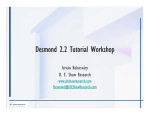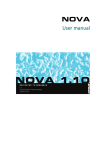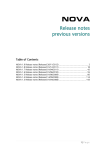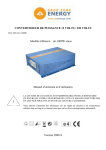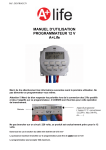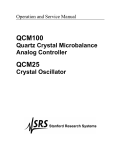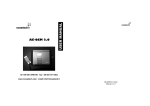Download Quick Start Guide for CHI-400A
Transcript
Quick Start Guide for CHI-400A This guide is meant to be a brief overview of functions and features. If you would like to use more features, or have any questions about the operation of the instrument, please see the user’s manual. Tips: - - - If you receive an overflow error in any experiment, simple adjust the sensitivity for the run in the parameters control panel as described below. Electrodes are assigned in the following manner: green = working, white = reference, red = counter and black = auxiliary. In most experiments, the auxiliary electrode is not used. When the QCM cell is used, the working electrode is the exposed side of the crystal, and the green alligator clip need not be attached. Be certain to store the reference electrode in the container provided submerged in 3M KCl, so that it does not dry out. Once the QCM is turned on, especially in the presence of a liquid medium, it may take half an hour or more to come to equilibrium and give a steady reading. Please take this into account when planning experiments. When running longer experiments, equilibration is more important, as the drift in frequency may increase over time. Be certain to polish the button electrodes before use to make sure that you have a good connection, and that no contaminants are introduced in to the system. If readings still seem off after polishing, run “multi-potential steps” from -0.6V to 1.4V with several cycles. This will evolve Hydrogen and Oxygen which will “scrub” the electrode surface. Choosing a Method and Setting Parameters: In order to chose an experiment to run, press the button circled below, and the dialog box shown will appear. Once you have chosen which experiment you would like to run, the parameters for the experiment must be set. The parameters box may appear once you select an experiment. If it does not, it can be opened with the parameters menu button: Each method has its own specific parameters which must be set before running an experiment. If you wish to perform another run with different parameters, simply click the parameters button again and make the necessary changes. The QCM/EQCM Cell When running any experiment using the QCM/EQCM cell and it is important to make sure that the cell is configured to use the correct frequency. Other settings specific to experiments, may also be adjusted in the following way. Click Control in the top bar and select Cell.... Ensure that the correct crystal frequency is listed. Taking drift issues into consideration, it is also a good idea to select the “cell on between runs” checkbox, to keep the crystal oscillating at all times. Sample CV’s Containing only 0.1M KNO3 supporting electrolyte, with Pt working/counter and AgCl/Ag reference electrodes. Containing 0.1M KNO3 as well as 0.01M K[Fe(CN)6], this illustrates the oxidation and reduction of a solvated species (in this case Fe2+/Fe3+) due to a varying potential Cu Deposition Copper deposition can be used to analyze the active area of the EQCM crystal. This is done by converting the measured current to number of ions deposited and plugging the mass change into the Sauerbrey equation. The average of several runs should be used to obtain more accurate values of “A” for use in further calculations. In order to deposit copper, the potential should be held at around -0.3V. While applying this constant potential, the change in frequency must also be recorded using the QCM. In order to perform this technique, we use a solution of about 0.1M KNO3 and 0.01M CuSO4 and run an “Amperometric i-t curve” with the “QCM on” box checked. The output of the run can then be analyzed as described above. Saving Data: Each project can be saved simply by clicking File->Save As, and choosing a destination. The file will be saved as a .bin type that is only readable by the CHI program. If you would like to be able to manipulate your data, or open the files on another program (such as Excel), then you must first save it as a .bin and then use the option in the File menu to convert the file to text. This text file can then be manipulated however you like. For instructions on how to import it to Excel, please see the QCM write up on the Ward Group website.







